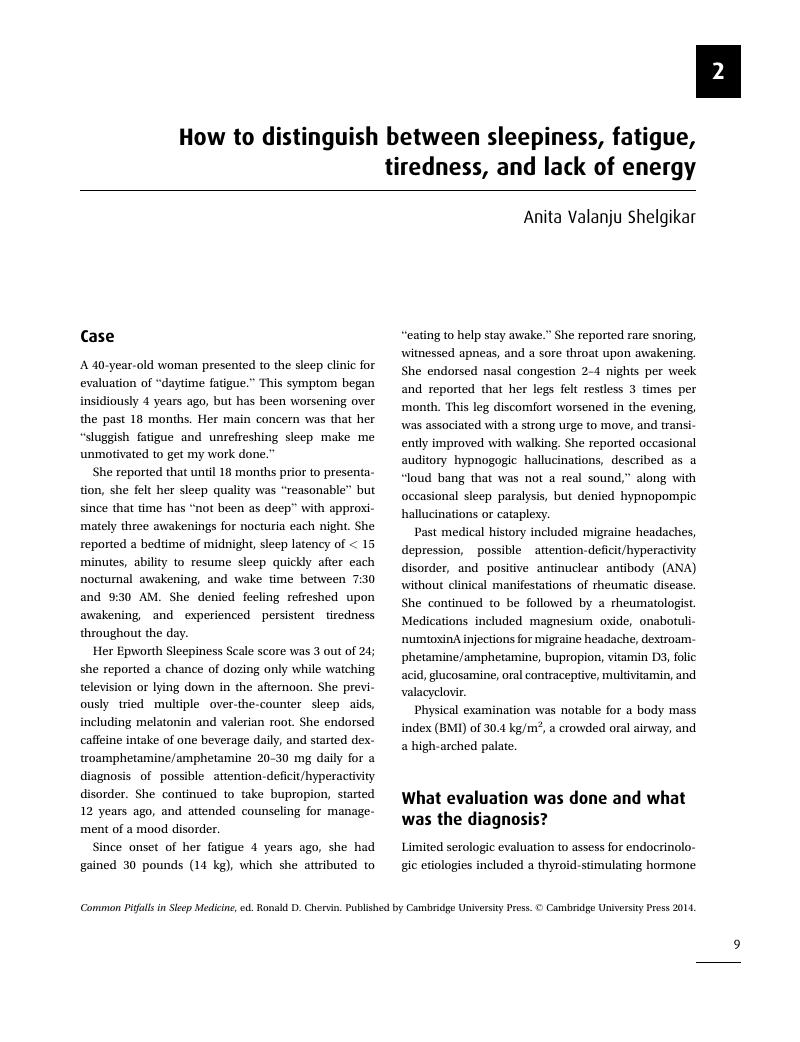Book contents
- Common Pitfalls in Sleep Medicine
- Common Pitfalls in Sleep Medicine
- Copyright page
- Contents
- Contributors
- Preface
- Acknowledgements
- 1 Introduction: the complexity, challenges, and rewards of effective sleep medicine
- Section one Sleepiness versus fatigue, tiredness, and lack of energy
- 2 How to distinguish between sleepiness, fatigue, tiredness, and lack of energy
- 3 A patient with prominent fatigue, tiredness, or lack of energy rather than sleepiness may still have a sleep disorder
- 4 Fatigue, tiredness, and lack of energy, not just sleepiness, can improve considerably when a sleep disorder is treated
- 5 Patients with narcolepsy, in contrast to sleep apnea, more often choose to describe the problem as “sleepiness” rather than using other terms
- 6 Patients with fatigue and sleepiness: multiple sclerosis
- Section two Assessment of daytime sleepiness
- Section three Diagnosis of narcolepsy
- Section Four Diagnosis of obstructive sleep apnea
- Section Five Positive airway pressure to treat obstructive sleep apnea
- Section Six Alternatives to positive airway pressure in the treatment of obstructive sleep apnea
- Section Seven Diagnosis and treatment of chronic insomnia
- Section Eight Restless legs syndrome and periodic leg movements
- Section Nine Parasomnias
- Section Ten Circadian rhythm sleep disorders
- Section Eleven Missed diagnoses of obstructive sleep apnea can exacerbate medical and neurologic conditions
- Section Twelve Sleep in children
- Section Thirteen Sleep in older persons
- Index
2 - How to distinguish between sleepiness, fatigue, tiredness, and lack of energy
from Section one - Sleepiness versus fatigue, tiredness, and lack of energy
Published online by Cambridge University Press: 05 April 2014
- Common Pitfalls in Sleep Medicine
- Common Pitfalls in Sleep Medicine
- Copyright page
- Contents
- Contributors
- Preface
- Acknowledgements
- 1 Introduction: the complexity, challenges, and rewards of effective sleep medicine
- Section one Sleepiness versus fatigue, tiredness, and lack of energy
- 2 How to distinguish between sleepiness, fatigue, tiredness, and lack of energy
- 3 A patient with prominent fatigue, tiredness, or lack of energy rather than sleepiness may still have a sleep disorder
- 4 Fatigue, tiredness, and lack of energy, not just sleepiness, can improve considerably when a sleep disorder is treated
- 5 Patients with narcolepsy, in contrast to sleep apnea, more often choose to describe the problem as “sleepiness” rather than using other terms
- 6 Patients with fatigue and sleepiness: multiple sclerosis
- Section two Assessment of daytime sleepiness
- Section three Diagnosis of narcolepsy
- Section Four Diagnosis of obstructive sleep apnea
- Section Five Positive airway pressure to treat obstructive sleep apnea
- Section Six Alternatives to positive airway pressure in the treatment of obstructive sleep apnea
- Section Seven Diagnosis and treatment of chronic insomnia
- Section Eight Restless legs syndrome and periodic leg movements
- Section Nine Parasomnias
- Section Ten Circadian rhythm sleep disorders
- Section Eleven Missed diagnoses of obstructive sleep apnea can exacerbate medical and neurologic conditions
- Section Twelve Sleep in children
- Section Thirteen Sleep in older persons
- Index
Summary

- Type
- Chapter
- Information
- Common Pitfalls in Sleep MedicineCase-Based Learning, pp. 9 - 13Publisher: Cambridge University PressPrint publication year: 2014

